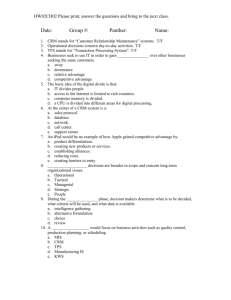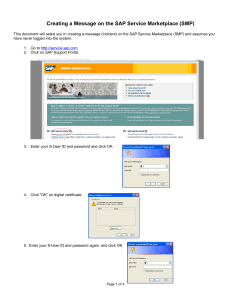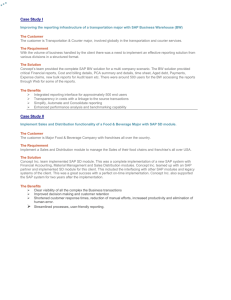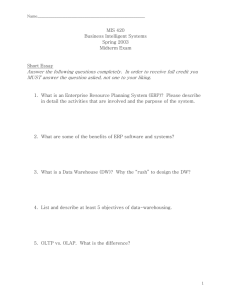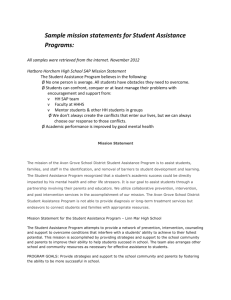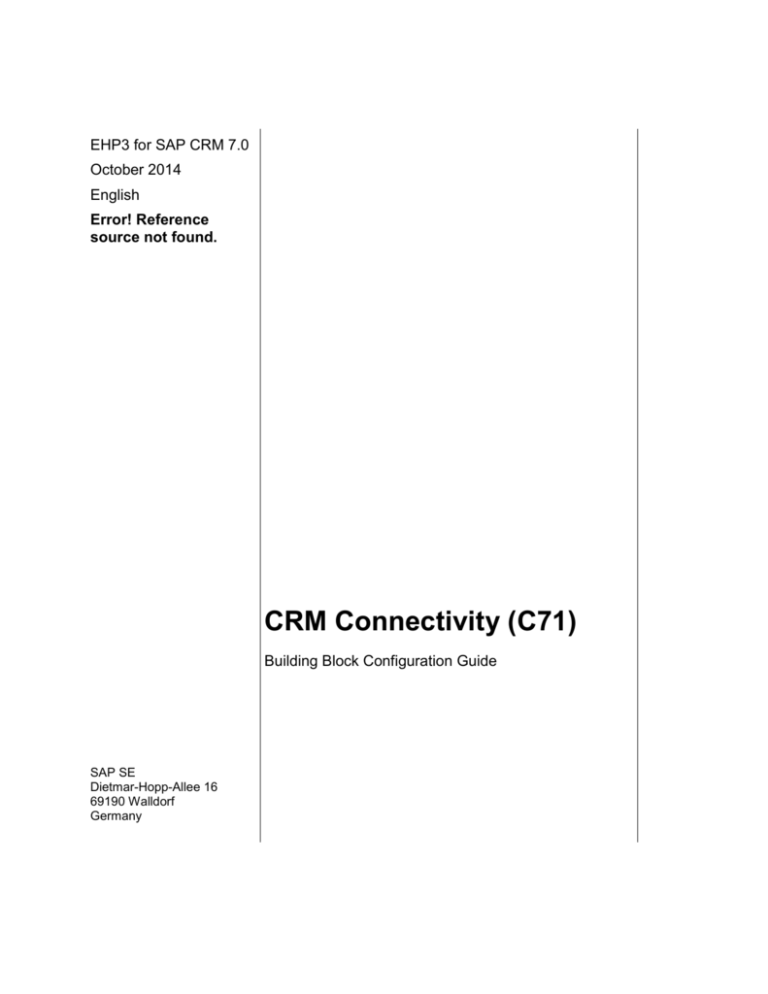
EHP3 for SAP CRM 7.0
October 2014
English
Error! Reference
source not found.
CRM Connectivity (C71)
Building Block Configuration Guide
SAP SE
Dietmar-Hopp-Allee 16
69190 Walldorf
Germany
SAP Best Practices
CRM Connectivity (C71): Configuration Guide
Copyright
© 2014 SAP SE or an SAP affiliate company. All rights reserved.
No part of this publication may be reproduced or transmitted in any form or for any purpose without the
express permission of SAP SE or an SAP affiliate company.
SAP and other SAP products and services mentioned herein as well as their respective logos are
trademarks or registered trademarks of SAP SE (or an SAP affiliate company) in Germany and other
countries. Please see http://global.sap.com/corporate-en/legal/copyright/index.epx#trademark for additional
trademark information and notices.
Some software products marketed by SAP SE and its distributors contain proprietary software components
of other software vendors.
National product specifications may vary.
These materials are provided by SAP SE or an SAP affiliate company for informational purposes only,
without representation or warranty of any kind, and SAP SE or its affiliated companies shall not be liable for
errors or omissions with respect to the materials. The only warranties for SAP SE or SAP affiliate company
products and services are those that are set forth in the express warranty statements accompanying such
products and services, if any. Nothing herein should be construed as constituting an additional warranty.
In particular, SAP SE or its affiliated companies have no obligation to pursue any course of business
outlined in this document or any related presentation, or to develop or release any functionality mentioned
therein. This document, or any related presentation, and SAP SE’s or its affiliated companies’ strategy and
possible future developments, products, and/or platform directions and functionality are all subject to change
and may be changed by SAP SE or its affiliated companies at any time for any reason without notice. The
information in this document is not a commitment, promise, or legal obligation to deliver any material, code,
or functionality. All forward-looking statements are subject to various risks and uncertainties that could cause
actual results to differ materially from expectations. Readers are cautioned not to place undue reliance on
these forward-looking statements, which speak only as of their dates, and they should not be relied upon in
making purchasing decisions.
© SAP SE
Page 2 of 14
SAP Best Practices
Revision
Change Date
CRM Connectivity (C71): Configuration Guide
Description
0
© SAP SE
Page 3 of 14
SAP Best Practices
CRM Connectivity (C71): Configuration Guide
Icons
Icon
Meaning
Caution
Example
Note
Recommendation
Syntax
Typographic Conventions
Type Style
Description
Example text
Words or characters that appear on the screen. These include field
names, screen titles, pushbuttons as well as menu names, paths and
options.
Cross-references to other documentation.
Example text
Emphasized words or phrases in body text, titles of graphics and tables.
EXAMPLE TEXT
Names of elements in the system. These include report names,
program names, transaction codes, table names, and individual key
words of a programming language, when surrounded by body text, for
example, SELECT and INCLUDE.
Example text
Screen output. This includes file and directory names and their paths,
messages, source code, names of variables and parameters as well as
names of installation, upgrade and database tools.
EXAMPLE TEXT
Keys on the keyboard, for example, function keys (such as F2) or the
ENTER key.
Example text
Exact user entry. These are words or characters that you enter in the
system exactly as they appear in the documentation.
<Example text>
Variable user entry. Pointed brackets indicate that you replace these
words and characters with appropriate entries.
© SAP SE
Page 4 of 14
SAP Best Practices
CRM Connectivity (C71): Configuration Guide
Contents
1
Purpose ................................................................................................................................ 6
2
CRM Settings ........................................................................................................................ 6
3
2.1
Creating RFC User in Client 000 (SAP CRM Client 000) .............................................. 6
2.2
Maintaining Profile for RFC User (SAP CRM Client 000).............................................. 7
2.3
Change Password of RFC User (SAP CRM Client 000) ............................................... 7
2.4
Creating RFC User (SAP CRM) .................................................................................... 8
2.5
Maintaining Profile for RFC User (SAP CRM) ............................................................... 9
2.6
Defining Password of RFC User (SAP CRM) ................................................................ 9
2.7
Creating RFC Destination for Replication & Realignment (targeting Appl. Client) ...... 10
2.8
Creating RFC Destination for Replication & Realignment (targeting Client 000) ........ 11
2.9
Changing Password of RFC User in RFC Destinations .............................................. 12
2.10
Registering Queues ..................................................................................................... 12
2.11
Starting Queue Demon and Queues ........................................................................... 13
Pre-Assembled Deployment ............................................................................................... 14
© SAP SE
Page 5 of 14
SAP Best Practices
CRM Connectivity (C71): Configuration Guide
CRM Connectivity: Configuration Guide
1
Purpose
This building block describes the activities that are necessary to connect the various components
of an SAP CRM system landscape.
2
CRM Settings
2.1
Creating RFC User in Client 000 (SAP CRM Client 000)
Use
An RFC user is required in client 000 for the replication and realignment queues.
Procedure
1. Access the activity using one of the following navigation options:
Transaction code
SU01
SAP CRM GUI menu
Architecture and Technology System Administration
User Maintenance Users
2. In the User field, enter RFCUSER.
3. Choose Create (F8).
4. Enter the following data:
Address tab page
Last Name
RFCUSER
Function
Default User for RFC connection
Logon data tab page
Password
WELCOME
Repeat Password
WELCOME
User type
System
Defaults tab page
Logon Language
EN
5. Save (Ctrl + S) your entries.
The system user RFCUSER is created with the initial password LOGIN.
© SAP SE
Page 6 of 14
SAP Best Practices
CRM Connectivity (C71): Configuration Guide
The user has the profile SAP_ALL assigned, which gives full authorization rights. If
this authorization is not applicable to your project you can restrict the rights of this
user according to SAP Note 0338537.
2.2
Maintaining Profile for RFC User (SAP CRM Client 000)
Use
Assignment of proper authorization profile to RFC user.
Procedure
1. Access the activity using one of the following navigation options:
Transaction code
SU01
SAP CRM menu
Architecture and Technology System Administration
User Maintenance Users
2. In the User field, enter RFCUSER.
3. Choose Change.
4. Enter the following data:
Profiles tab page
Profile
SAP_ALL
5. Save your entries.
The system user RFCUSER is created. To all created technical users the profiles
SAP_ALL is assigned manually, which gives them full authorization rights. If this
authorization is not applicable to your project you have to restrict the rights of these users
according to your company’s security policy (see SAP Note 0338537for details).
2.3
Change Password of RFC User (SAP CRM Client 000)
Use
With this activity you have to decide, if you want to define another password than INITIAL for the
new RFCUSER, which is a dialog user.
Procedure
1. Log on to system with RFCUSER and initial password INITIAL.
2. On the password change pop-up screen, change the password (for example, into
WELCOME) and confirm it.
3. Log off the system.
© SAP SE
Page 7 of 14
SAP Best Practices
CRM Connectivity (C71): Configuration Guide
4. Note the new password for system user RFCUSER for your project.
Result
The initial password has been successfully changed.
2.4
Creating RFC User (SAP CRM)
Use
An RFC user is required for setting up the connectivity between systems.
Procedure
1. Access the activity using one of the following navigation options:
Transaction code
SU01
SAP CRM GUI menu
Architecture and Technology System Administration User
Maintenance Users
2. In the User field, enter RFCUSER.
3. Choose Create (F8).
4. Enter the following data:
Address tab page
Last Name
RFCUSER
Function
Default User for RFC connection
Logon data tab page
User Type
Dialog
Password
INITIAL
Repeat Password
INITIAL
Defaults tab page
Logon Language
EN
5. Save your entries.
Result
The RFC user has been successfully created.
© SAP SE
Page 8 of 14
SAP Best Practices
2.5
CRM Connectivity (C71): Configuration Guide
Maintaining Profile for RFC User (SAP CRM)
Use
Assignment of proper authorization profile to RFC user.
Procedure
1. Access the activity using one of the following navigation options:
Transaction code
SU01
SAP CRM menu
Architecture and Technology System Administration User
Maintenance Users
2. In the User field, enter RFCUSER.
3. Choose Change.
4. Enter the following data:
Profiles tab page
Profile
Restrict the rights of these users according to your company’s security policy
(see SAP Note 338537 for details)
5. Save your entries.
Result
Proper authorization has been assigned to the new RFC user.
2.6
Defining Password of RFC User (SAP CRM)
Use
With this activity you have to decide, if you want to define another password than INITIAL for the
new RFCUSER (which is a dialog user).
Procedure
1. Log on to system with RFCUSER and initial password INITIAL.
2. On the password change pop-up screen, change the password (for example, into
WELCOME) and confirm it.
3. Log off the system.
4. Note the new password for system user RFCUSER for your project.
Result
You have successfully defined a new password for the RFC user.
© SAP SE
Page 9 of 14
SAP Best Practices
2.7
CRM Connectivity (C71): Configuration Guide
Creating RFC Destination for Replication & Realignment
(targeting Appl. Client)
Use
This step describes how to create an RFC destination for replication and realignment
Procedure
1. Access the activity using one of the following navigation options:
Transaction code
SM59
SAP CRM IMG menu
Customer Relationship Management CRM Middleware and
Related Components Communication Setup Define RFC
Destinations
2. Choose Create (F8).
3. Enter the following data:
Field
Entry
RFC Destination
SAPCRM_MW_RR_<CRM client>
Connection Type
L (Logical Destination)
Description
Processing R&R queues – application client
4. Choose Enter.
Logon & Security tab page
Authorization
Language
--
Client
<your CRM client>
User
RFCUSER
Password
WELCOME
Current user
Unencrypted password
5. Choose Enter.
Special Options
Set RFC Trace
Deselect
Slow RFC Connection
Deselect
6. Save your entries.
7. Confirm the information message.
8. You can now test your newly created RFC connection using Test connection.
© SAP SE
Page 10 of 14
SAP Best Practices
CRM Connectivity (C71): Configuration Guide
Result
You have successfully created the RFC connection for replication and realignment.
2.8
Creating RFC Destination for Replication & Realignment
(targeting Client 000)
This RFC connection has to be created in the current application client and not in
client 000.
Procedure
1. Access the activity using one of the following navigation options:
Transaction code
SM59
SAP CRM IMG menu
Customer Relationship Management CRM Middleware
and Related Components Communication Setup
Define RFC Destinations
2. Choose Create (F8).
3. Enter the following data:
Field
Entry
RFC Destination
SAPCRM_MW_RR_000
Connection Type
L (Reference Entry (Refers to other destination))
Description
Processing R&R queues – client 000
4. Choose Enter.
Logon/Security
Authorization
--
Language
--
Client
000
User
RFCUSER
Password
WELCOME
Current user
--
Unencrypted password
--
5. Save (Ctrl + S) your entries.
Result
The RFC connection has been successfully created in the current application client.
© SAP SE
Page 11 of 14
SAP Best Practices
2.9
CRM Connectivity (C71): Configuration Guide
Changing Password of RFC User in RFC Destinations
Use
RFC destinations are created automatically without a password for the RFC user. This password
has to be maintained manually.
Procedure
1. Access the activity using one of the following navigation options:
Transaction code
SM59
SAP CRM IMG menu
Customer Relationship Management CRM Middleware and
Related Components Communication Setup Define RFC
Destinations
2. Select the RFC connection and choose Change (F7).
3. Enter the following data:
Field
Entry
Logon/Security
Password
<Password, created in transaction SU01>: WELCOME
4. Save (Ctrl + S) your entries.
Result
You have successfully set a password for the RFC user.
2.10 Registering Queues
Use
All replication and realignment queues for the data exchange between the ERP system and the
CRM system are registered automatically when starting the replication.
The CSA queues have to be registered manually.
Procedure
1. Access the activity using one of the following navigation options:
Transaction code
SMQR
SAP CRM IMG menu
CRM CRM Middleware and Related Components Queue
Setup Register CSA Queues
2. Choose Registration.
3. On the Queue Registration screen, make the following entries:
© SAP SE
Page 12 of 14
SAP Best Practices
CRM Connectivity (C71): Configuration Guide
Field name
User action and values
Queue name
CSA*
Mode
D
Max. Runtime
60
Logical Destination
Attempts
30
Pause
300
Scheduler Monitoring
0
4. Register an additional queue:
Field name
User action and values
Queue name
R3A*
Mode
D
Max. Runtime
60
Logical Destination
Attempts
30
Pause
300
Scheduler Monitoring
5. Choose Continue (Enter).
Result
The CSA* and the R3A* queues are registered and are displayed in the queue list.
2.11 Starting Queue Demon and Queues
Use
This step describes how to release the queues and start the queue demon.
Procedure
1. Access the activity using one of the following navigation options:
Transaction code
SMOHQUEUE
SAP CRM GUI menu
Architecture and Technology Middleware Monitoring
Queues Monitor R&R Queues
2. Choose Start Queue Demon.
3. Release all queues by choosing Release Queue and selecting the valid line in the column
field Client.
© SAP SE
Page 13 of 14
SAP Best Practices
CRM Connectivity (C71): Configuration Guide
4. Perform step 3 for all the queues SUBCHECK, REALIGN, DEPENDENCY, EXTRACT,
EXTRACTBLK and AC_EXTRACT.
5. Perform steps 3 and 4 also for Client 000 by deselecting the checkbox Display current client
(XXX) only and choosing Refresh.
Result
You have successfully released all the queues SUBCHECK, REALIGN, DEPENDENCY,
EXTRACT, EXTRACTBLK and AC_EXTRACT and the queue demon has successfully been
started.
3
Pre-Assembled Deployment
Use
If you follow the “pre-assembled deployment” approach, some parts of the SAP Best Practices for
CRM content are already activated, whereas others still need to be activated. Therefore, all
configuration tasks are classified into one of the following categories:
Pre-Assembly (“Pre”): Configuration tasks classified as ‘Pre-Assembly’ have already
been executed and do not need to be re-activated during an implementation project.
Post-Processing (“Post”): ‘Post-Processing’ configuration tasks still need to be performed
in the target system landscape.
Some tasks can be classified as both ‘Pre-Assembly’ and ‘Post-Processing’; this means
that these tasks have been pre-assembled, but need to be checked and potentially
modified during the post-assembly phase.
ERP Integrated
CRM Standalone
Configuration Task
System
Pre
Post
Pre
Post
2.1 Creating RFC User in Client 000 (SAP CRM Client 000)
X
n.a.
n.a.
CRM
2.2 Maintaining Profile for RFC User (SAP CRM Client 000)
X
n.a.
n.a.
CRM
n.a.
n.a.
CRM
n.a.
n.a.
CRM
2.3 Change Password of RFC User (SAP CRM Client 000)
X
2.4 Creating RFC User (SAP CRM)
X
2.5 Maintaining Profile for RFC User (SAP CRM)
X
n.a.
n.a.
CRM
2.6 Defining Password of RFC User (SAP CRM)
X
n.a.
n.a.
CRM
2.7 Creating RFC Destination for Replication & Realignment
(targeting Appl. Client)
X
n.a.
n.a.
CRM
2.8 Creating RFC Destination for Replication & Realignment
(targeting Client 000)
X
n.a.
n.a.
CRM
2.9 Changing Password of RFC User in RFC Destinations
X
n.a.
n.a.
CRM
2.10 Registering Queues
X
n.a.
n.a.
CRM
2.11 Starting Queue Demon and Queues
X
n.a.
n.a.
CRM
© SAP SE
Page 14 of 14




